 E-mail:mery@ntl-bearing.com
E-mail:mery@ntl-bearing.com
Time: 26th Feb 2024 Click:356 seen
Definition of chain: A mechanical transmission element consisting of interconnected rotating links, with both
The characteristics of gears and belts.
(1) Classification of chains by industry
1. Industrial chain; 2. Automobile chain; 3. Motorcycle chain; 4. Other industries
Industry chain
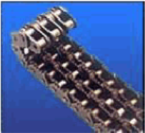

(2) Classify the chain according to its function;
1. Transmission chain; 2. Conveyor chain; 3. Traction chain; 4. Special chain
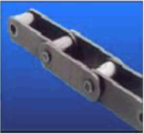

1. Transmission chains are divided into: extensible chain, roller chain, and toothed chain
1) Extensible chain: heavy-duty chain, used in coal drag mechanisms, elevator conveyors
Take it. Connect the links through the steel pin,
Chain: generally refers to metal chain links or rings, which are mostly used for mechanical transmission.
Transmission characteristics: the chain does not bend when subjected to side sliding action;
2) Roller chain: Roller chain is currently the most commonly used on various mechanical equipment.

The main structure of the strip is composed of chain plate, chain pin, sleeve, roller, etc.
Transmission characteristics: accurate transmission, no slippage, fixed speed ratio, strong load-bearing capacity,
High efficiency, good vibration absorption capability, strong environmental adaptability, etc.
3)Tooth chain: Also known as silent chain, it is composed of numerous flat separated blocks.
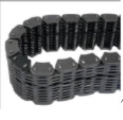
Each separated block can form various width of flexible tooth racks by connecting with pins.
By connecting the blocks with pins, infinitely flexible racks with various widths can be formed.
Transmission characteristics: stable, high efficiency, correct transmission (no slippage).
2. Conveyor chain: a chain used for transmitting power.
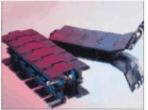
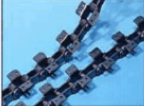
3.Traction chain: the chain used for traction.
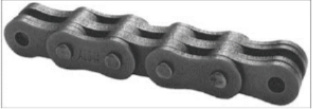
4. Other special chains: galvanized, nickel-plated chain, stainless steel roller chain, welded bending plate chain, and pointed
Tooth chain, clamping chain, combined casting chain, box conveyor chain, etc.
Standard model chain parameter table.pdf
Introduction to Common Materials for Chains
I. Metal materials
Metal materials are one of the most commonly used materials in chain manufacturing, mainly steel and stainless steel. Metal chains have high strength, wear resistance, and corrosion resistance, and are widely used in various applications that require bearing heavy loads and friction, such as bicycle chains, industrial chains, etc. The manufacturing of metal chains requires multiple processes, including cutting, forming, welding, heat treatment, and surface treatment.
II. Plastic material
Plastic materials are also one of the commonly used materials in chain manufacturing, mainly used for the manufacture of lightweight chains and chains for specific applications. Plastic chains are usually characterized by corrosion resistance, high impact strength, and lightweight, and are commonly used in food, chemical, and medical fields. Common plastic chains include polyamide (PA), polyoxymethylene (POM), and polycarbonate (PC).
III. Nylon material
Nylon material is a synthetic fiber with excellent wear resistance, high temperature resistance and corrosion resistance. Nylon chains have high strength and wear resistance, and are lightweight, widely used in textile, petroleum, chemical and other fields. The manufacturing of nylon chains requires fiber weaving, resin impregnation, heat treatment and other processes, making the manufacturing process complex.
IV. Polyester material
Polyester material is a kind of high molecular compound with excellent chemical stability and mechanical properties. Polyester chains are commonly used to manufacture chains with good corrosion resistance and wear resistance, and are commonly used in packaging, printing, textile and other fields. The manufacturing of polyester chains requires processes such as injection molding, stretching, heat treatment, etc., making the manufacturing process relatively complex.
V. Carbon fiber materials
Carbon fiber material is a high-performance fiber material with high strength, high modulus, lightweight and corrosion resistance. Carbon fiber chains are commonly used in applications that require high load bearing and lightweight, such as aerospace, racing, etc. The manufacturing process of carbon fiber chains involves fiber weaving, pre-impregnation, heat treatment, etc., making the manufacturing process relatively complex.
VI. 3D printing materials
3D printing is an emerging manufacturing technology that creates three-dimensional objects by layering materials. In the field of chain manufacturing, 3D printing technology is mainly used for rapid prototyping and manufacturing of special-purpose chains. Common 3D printing materials include metal powder, plastic, and composite materials. Chains manufactured through 3D printing technology have the characteristics of compact structure, light weight, and personalization, and can be widely applied in aerospace, medical, and other fields.
In addition, based on the working principle of the chain, there are several aspects that can be considered to ensure the normal use of the chain and extend its service life:
1. Maintain appropriate tension: The tension of the chain has a significant impact on its service life. If the chain is too tight, it can accelerate wear on the sprockets and chain; if the chain is too loose, it can lead to chain skipping or disengagement. Therefore, it is necessary to adjust the tension of the chain regularly based on the specific usage of the equipment.
2. Regular lubrication: Lubrication can effectively reduce friction between the sprockets and chain, reducing wear and tear, and increasing the service life of the chain. Depending on the usage and environment of the equipment, choose the appropriate lubricating oil or grease, and lubricate the chain regularly.
3. Correct installation and removal: When installing and removing chains, it is necessary to operate strictly according to the instructions or technical requirements of the equipment to ensure that the installation and removal of chains are correct and prevent damage due to improper operation.
4. Regular inspection and replacement: Regularly inspect the chain to check for wear, cracks, deformation, etc. If the chain is severely worn or damaged, it should be replaced in a timely manner. At the same time, it is also necessary to replace the chain regularly based on the usage of the equipment.
5. Pay attention to the working environment: The working environment of the chain also has a significant impact on its service life. If the equipment works in harsh environments such as high temperature, humidity, dust, etc., it is necessary to take corresponding protective measures to reduce damage to the chain.
In conclusion, to ensure the normal use of chains and extend their service life, it is necessary to consider multiple aspects including appropriate tension, regular lubrication, correct installation and removal, regular inspection and replacement, as well as attention to the working environment. At the same time, it is also necessary to conduct targeted maintenance and upkeep based on the specific usage and requirements of the equipment.
Sprocket specifications,
sizes ranging from 04B to 32B, parameters include pitch, roller diameter, tooth size, row spacing and chain inner width, etc. The pitch value in the table = chain number X (25.4/16) mm. The suffix A of the chain number indicates the A series, which is equivalent to the A series of the international standard ISO606-82 for roller chains, and equivalent to the American standard ANSI B29.1-75 for roller chains; the B series is equivalent to the B series of ISO606-82 , equivalent to the British roller chain standard BS228-84. In our country, A series is mainly used for design and export, while B series is mainly used for maintenance and export. "Chinese translation:
Sprocket specifications refer to sizes in the range of 04B to 32B, and parameters include pitch, roller diameter, tooth size, row spacing and chain inner width, etc. The pitch value in the table is calculated based on the number of chain numbers. The specific formula is: pitch value = number of chain numbers × (25.4/16) mm. The suffix A of the chain number indicates the A series, which is equivalent to the A series of the international standard ISO606-82 and equivalent to the American standard ANSI B29.1-75. The B series is equivalent to the B series of ISO606-82 and equivalent to the British roller chain standard BS228-84. In our country, A series is mainly designed and exported, while B series is mainly used for repair and export.
Chain industry market status
1. Global chain market size
The global chain market is vast. According to data from market research Statista, the global chain market size was about $56.1 billion in 2019 and is expected to reach $69.5 billion by 2027. Currently, the major chain production countries in the world include Germany, Japan, the United States and China.
2. China chain market size
China is one of the largest chain manufacturing countries in the world, with numerous chain production enterprises. According to data from the China Machinery Industry Federation, the output value of China's chain industry reached about 18.35 billion yuan in 2019, of which the output value of products such as transmission chains, conveyor chains, construction chains, industrial and mining chains, and sprockets was relatively large.
3. Competition pattern of chain industry
Currently, the competition pattern of the global chain market is quite fierce. In the Chinese market, some large enterprises have advanced manufacturing technology and large-scale production bases, and have strong market competitiveness. At the same time, some small and medium-sized enterprises are also seeking market opportunities through technological innovation and diversified development.
Second, Market development trends of the chain industry
1. Promotion of technological innovation
With the acceleration of industrial upgrading and technological innovation, the chain industry is also continuously developing towards high-end manufacturing and intelligence. Many enterprises begin to focus on R&D investment, develop new products, and improve technological content and added value.
2. Optimization of industrial chain
In order to improve production efficiency and product quality, the chain industry is gradually moving towards industrial chain collaboration and optimization, strengthening upstream and downstream collaborative cooperation and supply chain management. At the same time, with the help of Internet technology, information management and logistics配送optimization are achieved, thereby improving overall competitiveness.
3. Expansion of application fields
Chains are widely used in various fields such as transmission, conveyance, lifting, traction and so on. In recent years, with the emergence of new materials and new technologies, the chain industry has begun to be involved in fields such as aerospace, nuclear power, high-speed rail, and other fields with broader market prospects.
4. Increase in environmental protection and energy conservation requirements
Environmental protection and energy conservation have become the mainstream direction of social development. The chain industry also needs to pay attention to research and application in the field of environmental protection. For example, optimization can be carried out in terms of chain lubrication and material selection to improve product reliability and service life.
Thirdly, challenges facing the chain industry
1. Increase in market competition
With the intensification of domestic and foreign market competition, the chain industry faces problems such as price wars, product homogeneity, and insufficient brand influence. It is necessary to strengthen marketing and brand building, increase product added value and market share.
2. Increase in technical requirements
With the improvement of performance and quality requirements for chains in various industries, chain manufacturing enterprises need to strengthen R&D investment, improve technical response speed, and further improve research and development capabilities and innovation capabilities.
3. Environmental protection, energy conservation and safety requirements
Environmental protection, energy conservation and safety have become important keywords for the chain industry. Chain manufacturing enterprises need to strengthen environmental protection and safety management in product research and development, production and application processes, comply with national and international environmental protection, energy conservation and safety policies, reduce energy consumption and pollution emissions levels, and contribute to sustainable development of the industry.
In summary, as the main guarantee for space transmission components, the chain industry has important economic significance and market value. There are tremendous potential and challenges in terms of technological innovation, industrial chain optimization, application field expansion, environmental protection and energy conservation.